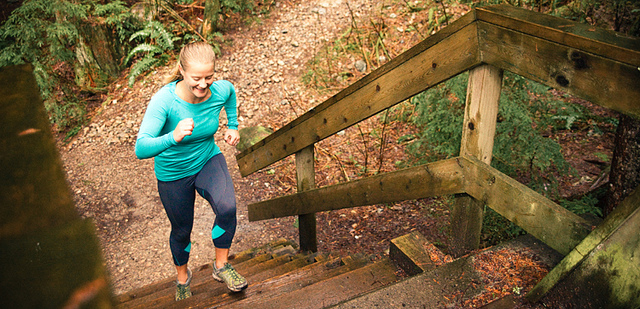You wanna know how to to burn more calories? You sure? Because what I’m about to share with you isn’t gonna be easy.
After a few rounds of this, your legs will literally feel like they’re on fire, which is really quite ironic since they’ll be dripping with sweat. Your lungs will have you believe you’re a fire-breathing dragon and your heart will feel like it’s pumping battery acid. And if you’re a redhead like me, your entire cranium may morph into a fireball for a few minutes afterward. It’s ok, I’ve survived this many times myself – just don’t inhale too much smoke. Now, if that wasn’t enough already, the good news is that you’ll also be burning calories and burning fat like a pro. If that sounds like a fun time, then you and I share some of the same character flaws, and this will be right up your alley.

I know, I know. You’re probably looking for a top 10 list of suggestions for how to burn more calories – with neatly arranged bullet points and liberal use of the bold feature. But the truth is that burning calories isn’t exactly rocket-science, folks. Everything we do burns calories. Eating burns calories. Digestion burns calories. I know it’s hard to believe, but sleeping and even just thinking burn calories, too. So, if you’re looking for advice like “drink more caffeinated green tea and chew gum all day,” then look elsewhere sweetie-pie. This place is reserved for men and women of resolve. There are no wusses in this corner.
If you’re still with me and you want to know how to burn more calories than a triathlete on adrenaline (or something like that), then the following strategy will be just what the doctor ordered. But don’t say I didn’t warn you! I’m going to hand the mic over to my friend and colleague, Tom Venuto, who is a respected fat loss expert who has more than a few tricks up his sleeve to help you burn more calories. This one, in particular, is a doozie. Cue the evil laugh.
How to Burn More Calories Using An Insanely Effective Type of Interval Training
By Tom Venuto
www.BurnTheFat.com
High intensity interval training can be done in a variety of different ways. Here’s a wickedly-effective type of interval training: it requires no machines or fancy equipment, you can do it outside in the sunshine and fresh air, it develops killer conditioning, carves out legs like a sprinter, and burns calories at an accelerated rate…
In other articles about running/aerobics and high intensity interval training, as well as in my fat loss books, I’ve written about how you can integrate both traditional steady state cardio as well as high intensity interval training into your training program for optimal body composition improvement, improved health, and increased fitness – you don’t have to choose one form of cardio or the other. In fact, settling into dogmatic views about cardio will only limit you.
Traditional steady state cardio is pretty much self-explanatory and intuitive. But many people are still confused about the best way to do interval training.
An Insanely Effective Way To Do Interval Cardio
I’m not sure if there is a single best way to do intervals because there are so many choices and everyone is different in their goals, interests and personal preferences, so “best” is a relative thing. But let me give you one of my personal favorites that is breathtakingly effective:
Stair sprinting!

Your typical interval workout in the gym might be on a stationary cycle, treadmill or stairclimber with short 30-60 second bursts of high speed and/or resistance, followed by a 60-120 second period of low intensity recovery. That’s usually a 1:1 or 1:2 work to recovery interval. You then rinse and repeat for the desired number of intervals, usually between 6 and 12.
I sometimes have access to a great set of university stadium steps with a straight shot right up – 52 steps.
Sprinting it takes about 10 seconds or so, walking down about 30 seconds. Those are short intervals with a 1:3 work to recovery interval ratio. That wasn’t by design, it just happens to be how long it takes to run up and walk down that particular flight of stairs, but co-incidentally, that fits within common recommendations for short sprint-style intervals.
I make sure I’m warmed up first, I usually start with a couple flights up at a slow jog then a run, before sprinting, usually 10-12 rounds.
Even if you jog/run instead of sprint, (or pause briefly at the bottom of the stairs), when you do the math, you can figure that this usually doesn’t take more than 10-12 minutes.
Why do I like stadium step sprinting?
1. Stair sprinting is a time saver. Like other forms of interval training, it’s entirely possible to get as much if not more cardiovascular conditioning in 10-15 minutes than you’d get from a much longer session of slower cardio (depending on the intensity and effort levels).
2. Stair sprinting is engaging. Many people get bored doing long slow to medium intensity cardio sessions. This is a great way to break up the monotony of traditional cardio workouts. Even though it’s tough, it’s actually kind of fun.
3. Stair sprinting is incredible for leg development. As a bodybuilder, I like to look at all types of training not only in terms of conditioning, fat loss and health, but also whether they will add or detract from the physique. I find that brief but intense stair workouts are amazing for leg development – quads, hamstrings, glutes and even your calves. In fact, I started training on the stairs more than 20 years ago, and I always considered it as much if not more of a leg workout than anything else.
4. Stair sprinting can be done outside. If you have access to stadium steps, as opposed to just a stairwell, you can enjoy the sun and fresh air.
How to integrate stair running into your training program
If you’re an overachiever type, you might be tempted to do these sprint workouts in addition to your current strength training and cardio workload.
However, keep in mind that intensity and duration are inversely proportional. When you do high intensity cardio or all out sprints, you are condensing more work into less time. That means the best part is, you can do a brief but intense stair workout instead of one of your long cardio sessions rather than in addition to them.
Recommendation: Start with one session per week, then progress to two if you choose. You can do traditional cardio the other days of the week if you want or need additional calorie-burning. Lower intensity cardio in between weight training and interval workouts can also serve as active recovery.
Not everyone has access to a full flight of stadium steps, as you might find at a local University. Running flights of stairs in a high rise is another effective and no-cost way to train on stairs. Although you can’t truly sprint with twists and turns on each floor, you can jog/run.
No stairs? Hills will get the job done too and they may provide you with more flexibility in the length/duration of your intervals. I’ve found some big hills at just the right grade of incline that I can do 30-45 second runs up, with about 90-120 seconds walk down. Grassy hills are nice, when available, as they spare you some of the impact from running on the concrete.
Sprinting up stairs is not for everyone. If you have a history of health problems or orthopedic issues, check with your doctor before doing any kind of high intensity training and of course, don’t train through the pain of injury. If you are significantly overweight, it may be a challenge just to walk up stairs, let alone run up, not to mention it might create undue stress on your joints. But as you get lighter and fitter, it’s a challenge you might slowly work toward.
Be sure to build up gradually and adjust the workout based on your current health and fitness level. You could start with as few as 4-6 rounds and build up from there. You can also start with jogging up the stairs, then progress to running, then move to sprints. Be sure you are fully prepared and warmed up before attempting all out sprints as sprinting when unprepared is a notorious source of hamstring pulls.
Some coaches believe that running uphill is safer than sprinting flat surfaces. Writing for Staley Training.com, Coach Steven Morris says, “Another great reason to hill sprint: even an athlete with horrendous running form will be safe running hills. This is simply because the hill does NOT allow the athlete to over-stride nor does it allow them to reach top speed, both major factors in hamstring injuries.”
Stair sprinting is a perfect complement to the cardio portion in my Burn The Fat, Feed The Muscle program. If you’re healthy and already fit, try this advanced interval workout and I think you’ll be pleasantly surprised with the results!
Train hard and expect success!
Tom Venuto, author of
Burn The Fat, Feed The Muscle
www.BurnTheFat.com
About the Author:
Tom Venuto is the author of the #1 best seller, Burn the Fat, Feed the Muscle: Fat Burning Secrets of the World’s Best Bodybuilders and Fitness Models. Tom is a lifetime natural bodybuilder and fat loss expert who achieved an astonishing 3.7% body fat level without drugs or supplements. Discover how to increase your metabolism and burn stubborn body fat, find out which foods burn fat and which foods turn to fat, plus get a free fat loss report and mini course by visiting Tom’s site at: www.BurnTheFat.com
I have found that if I need to get into shape quickly, scrunched for time, that stair running (or just plain ol’ hiking in steep terrain) has effective results. I am blessed with location because my town is topographically very hilly and up the hill from my house is the local university and leading out of an old, limestone quarry on campus is a stairway (cut steep up the cliff that climbs out of the quarry) that contains 121 steps. Getting there (up to mile of hill) is a good warm-up and then you have the steps for the workout. I have found that when I include stair running, my conditioning time is shortened and my legs definitely tone up.
Good stuff, Kevin. I’ve also got a bunch of hills around my home – 1 hill that gradually climbs over the course of 1.5 miles, and a couple of short, steep ones, too.